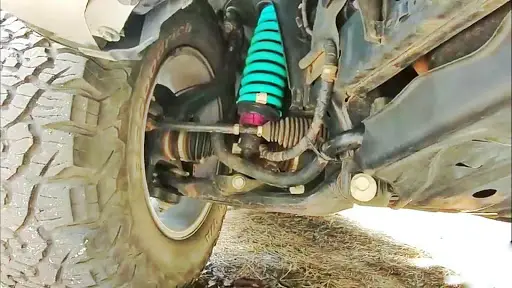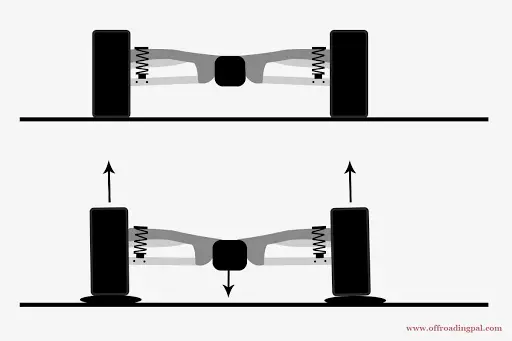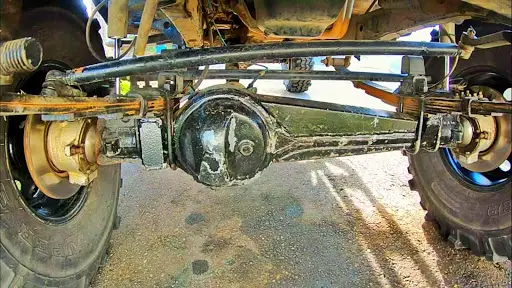There are some discussions out there on the old school suspension vs new school suspension systems. one group says independent front suspension is better while others said solid/beam axles are better for off-roading.
Both have their own pros and cons in different territories.
Independent front suspension is good for mostly the high speed off-roading situations.
As an example for sand off-roading races this will be better. Handling and comfort are also better in IFS. But there are downsides also with this system.
In this article we’ll look at what are these IFS and solid axles and their pros , cons and what may be best for your off-roading needs.
Contents
What is an independent front suspension ?

Most of the modern vehicles come with this type of suspension. As examples you can see this in ford ranger, Pajero.
This independent front suspension system has two separate independently working suspension systems for front two wheels.
This one set has a lower and upper control arms (wish bone), axle bar, CV joint.
There is no direct solid connection between two wheels.
Because of this set up if one wheel goes above an obstacle that wheel independently moves up and down.
Other wheels do not get any impact from that obstacle.
Because of this independently working manner it got the name independent suspension system.
There are IRS or independent rear suspensions also working in similar way.
Here we discussed on the independent front suspensions. Pajero’s and Y62 patrol jeeps have those IFS and IRS both.
pros of an IFS
Comfort : I said earlier this is the modern suspension system.
Because of their independent movement over obstacles, if one side hits a rock or something that side will absorb it while the other side is moving normally forward.
Passengers inside the vehicle don’t get much impact. So the comfort is high in these vehicles.
Handling : Handling is way better in independent front suspension, because movements of the wheels are not forced by one another.
So that it can easily control the vehicle regardless of the terrain obstacles.
Clearance : clearance is better with diff tucked up.
The wish bones are inclined down and differential is placed near the body.so underbody clearance is high.
Alignment : Can get a better alignment. Because one side has a lot of parts.
So a lot of adjustments can be done with those parts to get a better adjustment.
Weight : ifs have lighter parts used in it’s assembly.so overall weight is low. Because of that fuel efficiency is high.
Cons of an IFS
Strength : Due to having a chunk of small parts for the smooth comfortable ride, it’s harder to withstand against extreme terrains than a beam axle.
Another thing is the suspension system is compact with the chassis. It’s not separate like beam axle.
So if a decent impact happens most probably the chassis also can be damaged.
Other thing is older vehicles are made stronger.modern vehicles are made for crumble.
Because they are made to save the passengers while energy of an impact destroying the vehicle.
That means when off-roading these modern ifs vehicles are not much stronger like vehicles with beam axles.
Alignment : Because of having a lot of small parts that can adjust, alignment can be easily knocked out a bit with rough terrain conditions.
Load handling : These are designed for comfort and handling. The parts are not so strong. These are not designed for heavy load handlings, towing heavy weights.
If you want you can upgrade the suspension system for those purposes. But primarily they are not for that purpose.
Diff centers : They are most of the time smaller and weaker. So they can’t handle bigger tires like the beam axles.
CV joints : In IFS vehicles there are two CV joints on one side and they are covered with thin rubber boots with grease in it.
These joints and bars are thinner and weaker.
Because of two joints during movements , those joints can get into horrible angles and break in off-roading.
Another thing is when off-roading those rubber boots can be pierced by things on terrains and can be contaminated by mud,dust,sand ,water and could cause so many problems with those joints.
Articulations : Articulations are low due to limited flexing ability. That means on uneven terrains one or two wheels can easily lift off the ground and lose traction.
Suspension compression : If these vehicles take an inclined sand dune with a speed, the angle between two suspension arms increases when hitting.
Because of that the wheels are lifting when the middle of the vehicle tend to press down like in the below diagram.
So there is an ability to be damaged by impacts when driving in sand dunes.

Modifying : Not easy to modify with adding bigger tyres, lifting kits like in beam axles.
If you want to lift ifs you have to do some more modifications than a beam axle.
Cost : The prices of parts are very expensive. Having a lot of components means simply repairing costs is high.
What is an solid/live/beam axle

This is the old school version of axles. But some modern vehicles also still use these axles.
The famous example is jeep wrangler. They still use these solid axles for their off-roading jeeps.
Solid axle is simply a single beam axle that attaches the two wheels from two ends and middle it has the differential.
So the both wheels on the axle moves coordinating each other. If one wheel dips down in an uneven terrain other side wheel goes up like a seesaw.
The CV joints of this system only gives the ability to turn the wheel left and right around that joint.
It doesn’t allow the wheel to move around the joint in the horizontal axis like in the IFS system.
Pros of a solid axle
Strength : There are bigger and less amount of components in this axles.so it can easily withstand big impacts on off roads.
The beams and all the parts are big and strong metal parts.
The IFS beam axle is attached separately from the chassi.
So if a decent impact happens it may damage the beam axle but it may not damage the chassis.
Comfort : In extremely uneven terrain with big holes, washouts , due to the high flexing ability the whole body moves nicely and gives way more comfort than an IFS vehicle which lifts its wheels off the ground.
Heavy loads : These are made for heavy loads. Can handle heavy loads , use for towing heavy weights.
For that don’t need much suspension upgrades
Modifying ability : These vehicles have a huge modifying ability. Adding lift suspensions kits , fitting big tyres anything is possible and easy.
Diff center : These vehicles have stronger bigger differentials, CV s and axles. Can easily handle large tyres
CV joints : They are large and stronger. They don’t have rubber boots either. So muds, water, dirt don’t contaminate these cv joints easily. That’s best for off-roading.
Wheel travel : Because the movement of the whole axel wheel flex is high. So wheels can move up and down in high distances.
That’s very useful for off-roading. All the wheels can keep the traction without lifting from the ground.
Sand dunes : This don’t lost it’s clearance when hitting sand dunes in highspeed like IFS. So best for sand off-roading.
Cost : Replacing or repairing is way more cheaper than repairing or replacing an IFS system.
Cons of solid axle
Handling : This is the old technology and handling is weak due to the beam axle.
Comfort : On a normal road or a normal off road comfortability is very low. If one side wheel hits on something the whole axle moves so that affects the passengers.
Clearance : Due to the pumpkin shape big differential in the middle of the axle the clearance is reduced.
Alignment : generally due to less amount of parts, can’t do lot of adjustments and alignments
Weight : weight is high due to heavy metal parts in building this axle.so in general use fuel efficiency is low due to overall weight being increased.
What would be the best for your needs?
So far I have told you pros and cons of both solid axles and IFS. So what may be suitable for you depends on what you are going to do with your vehicle.
If you find a more comfortable, fuel efficient, easy to handle vehicle IFS will do the job.
But if you are willing to beat rough extreme terrains and want to feel the real off-roading feel, a solid beam will do your job.
Another thing is in solid axles, if you have mechanical knowledge you may repair if something breaks in the middle of a terrain.
Due to the low amount of parts you could bring a few spare parts that frequently break.
I add that point because most of the time rock crawlers have to do this. I had explained those things in my rock crawling guide. If you need you can check that guide by clicking here.
So overall i think now you can decide what is suitable for your needs from this knowledge. Comment down below what’s your choice. I’d like to hear it.
If you find this article helpful share with your off-roading pals. You just have to click a share button below.
Have fun and safe off-roading !!



